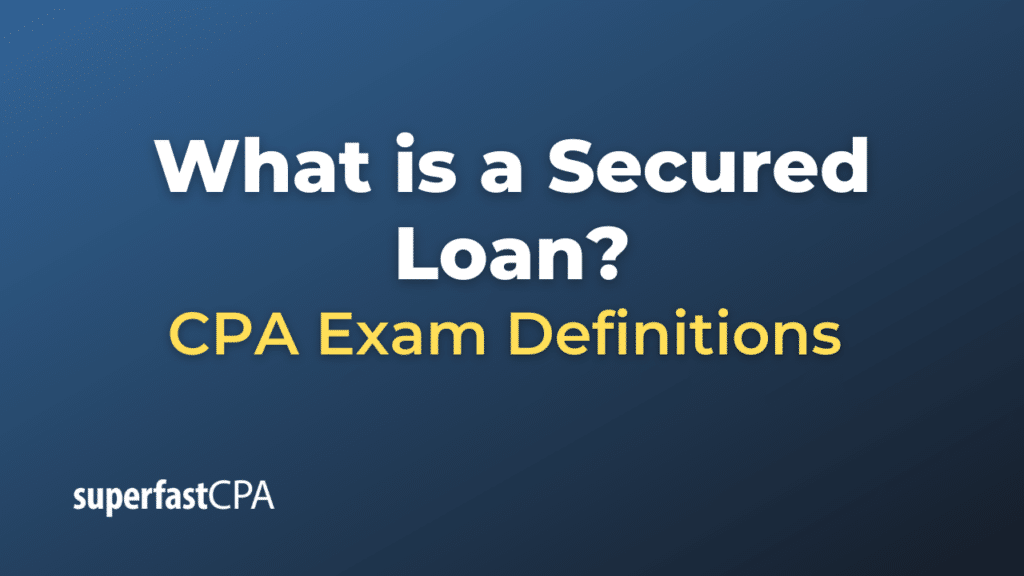Secured Loan
A secured loan is a type of loan in which the borrower pledges an asset (or assets) as collateral to guarantee the repayment of the loan. This collateral acts as a security for the lender. If the borrower defaults on the loan payments, the lender has the legal right to seize the collateral and sell it to recover the outstanding amount of the loan.
Features of a Secured Loan:
- Collateral: The defining feature of a secured loan is the presence of collateral. The collateral can be various assets such as real estate properties, vehicles, stocks, bonds, machinery, or other tangible assets.
- Reduced Risk for Lenders: Since the loan is backed by collateral, lenders usually consider secured loans to be lower risk compared to unsecured loans. This often translates to better loan terms for borrowers.
- Lower Interest Rates: Typically, secured loans come with lower interest rates than unsecured loans due to the reduced risk associated with having collateral.
- Loan Amount and Terms: The amount that can be borrowed is often tied to the value of the collateral. For instance, in a mortgage, the loan amount might be a certain percentage of the home’s appraised value. Additionally, secured loans often have longer repayment terms.
- Potential for Loss: While secured loans can offer better terms, there’s also a risk for borrowers. If they default on the loan, they can lose the asset that was pledged as collateral.
Common examples of secured loans include:
- Mortgages: A home loan where the house itself serves as collateral.
- Car Loans: Loans to purchase a vehicle where the vehicle itself serves as collateral.
- Home Equity Loans: Loans based on the equity (the portion of the home’s value owned outright by the homeowner) in a person’s home.
- Pawnshop Loans: Small loans where items of personal property are used as collateral.
In contrast, an unsecured loan doesn’t involve any collateral. Instead, it’s based on the borrower’s creditworthiness. Common unsecured loans include credit cards, personal loans, and student loans. Because they represent a higher risk for lenders, unsecured loans generally come with higher interest rates.
Example of a Secured Loan
Carlos has always been passionate about classic cars. While browsing a local dealership, he comes across a restored 1965 Ford Mustang priced at $30,000. Carlos has $10,000 saved up, but he needs an additional $20,000 to make the purchase.
Securing the Loan:
- Approaching the Bank: Carlos visits his local bank, RiverBank, to apply for a car loan. The bank is willing to lend him the $20,000, but they require the car itself as collateral to secure the loan.
- Loan Agreement: Carlos and RiverBank finalize a loan agreement. The terms state that if Carlos defaults on his loan repayments, RiverBank has the right to repossess and sell the Mustang to recover the owed amount.
- Purchasing the Car: With the loan amount and his savings combined, Carlos buys the Mustang. While he’s the owner of the car, the bank essentially has a “lien” on it, which means they have a claim to the car until the loan is fully repaid.
Future Possibilities:
- Regular Payments: Carlos makes his monthly payments diligently. Over time, as he repays the loan, his equity in the car increases until he fully owns it without any claims from the bank.
- Potential Default Scenario : Suppose Carlos faced unexpected financial hardships and stopped making loan payments. After multiple missed payments and not being able to work out a modified payment plan with Carlos, RiverBank would have the right to repossess the Mustang. Once repossessed, the bank could sell the car. If the selling price is less than what Carlos owed, he might still be responsible for the difference. If the car sells for more than the owed amount, the surplus would typically be returned to Carlos.
This example showcases the fundamental principles of a secured loan. Carlos was able to obtain the funds he needed by pledging the purchased car as collateral. This collateral provided security for the bank, ensuring they had a means to recover their funds in case of a default. On Carlos’s side, while he benefited from the loan, he also bore the risk of potentially losing the car if he couldn’t keep up with payments.














